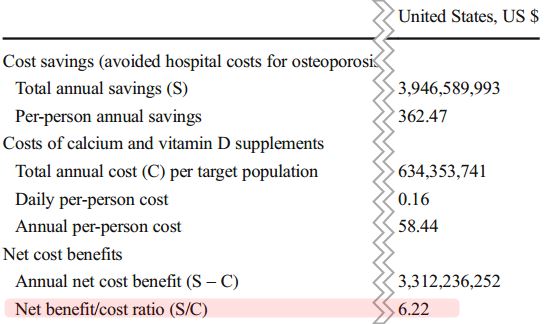Vitamin D and Calcium cost-effectively reduce falls and fractures
Cost-benefit analysis of calcium and vitamin D supplements.
Arch Osteoporos. 2019 Apr 30;14(1):50. doi: 10.1007/s11657-019-0589-y.
Weaver CM1, Bischoff-Ferrari HA2,3,4, Shanahan CJ5.
📄 Download the PDF from Vitamin D Life

$6 hospital cost saved for every $1 of cost for Calcium and Vitamin D

If all adults with osteoporosis in the European Union (EU) and United States (US) used calcium and vitamin D supplements, it could prevent more than 500,000 fractures/year in the EU and more than 300,000/year in the US and save approximately €5.7 billion and US $3.3 billion annually.
PURPOSE: Evaluate the cost-effectiveness of calcium/vitamin D supplementation for preventing osteoporotic fractures.
METHODS:
A cost-benefit analysis tool was used to estimate the net cost savings from reduced fracture-related hospital expenses if adults with osteoporosis in the EU and US used calcium/vitamin D supplements. A 14% relative risk reduction of fracture with calcium/vitamin D supplementation from a recent systematic review and meta-analysis of randomized, controlled trials was used as the basis for the benefit estimate. Other model inputs were informed by epidemiologic, clinical, and cost data (2016-2017) obtained via the medical literature or public databases. Analyses estimated the total number of avoided fractures and associated cost savings with supplement use. Net cost benefit was calculated by subtracting the supplements' market costs from those savings.
RESULTS:
The > 30 million persons in the EU and nearly 11 million in US with osteoporosis experience about 3.9 million and 2.3 million fractures/year and have annual hospital costs exceeding €50 billion and $28 billion. If all persons with osteoporosis used calcium and vitamin D supplements, there would be an estimated 544,687 fewer fractures/year in the EU and 323,566 fewer in the US, saving over €6.9 billion and $3.9 billion; the net cost benefit would be €5,710,277,330 and $3,312,236,252, respectively.
CONCLUSIONS:
Calcium and vitamin D supplements are highly cost-effective, and expanded use could considerably reduce fractures and related costs. Although these analyses included individuals aged ≥ 50 years, the observed effects are likely driven by benefits observed in those aged ≥ 65 years.
